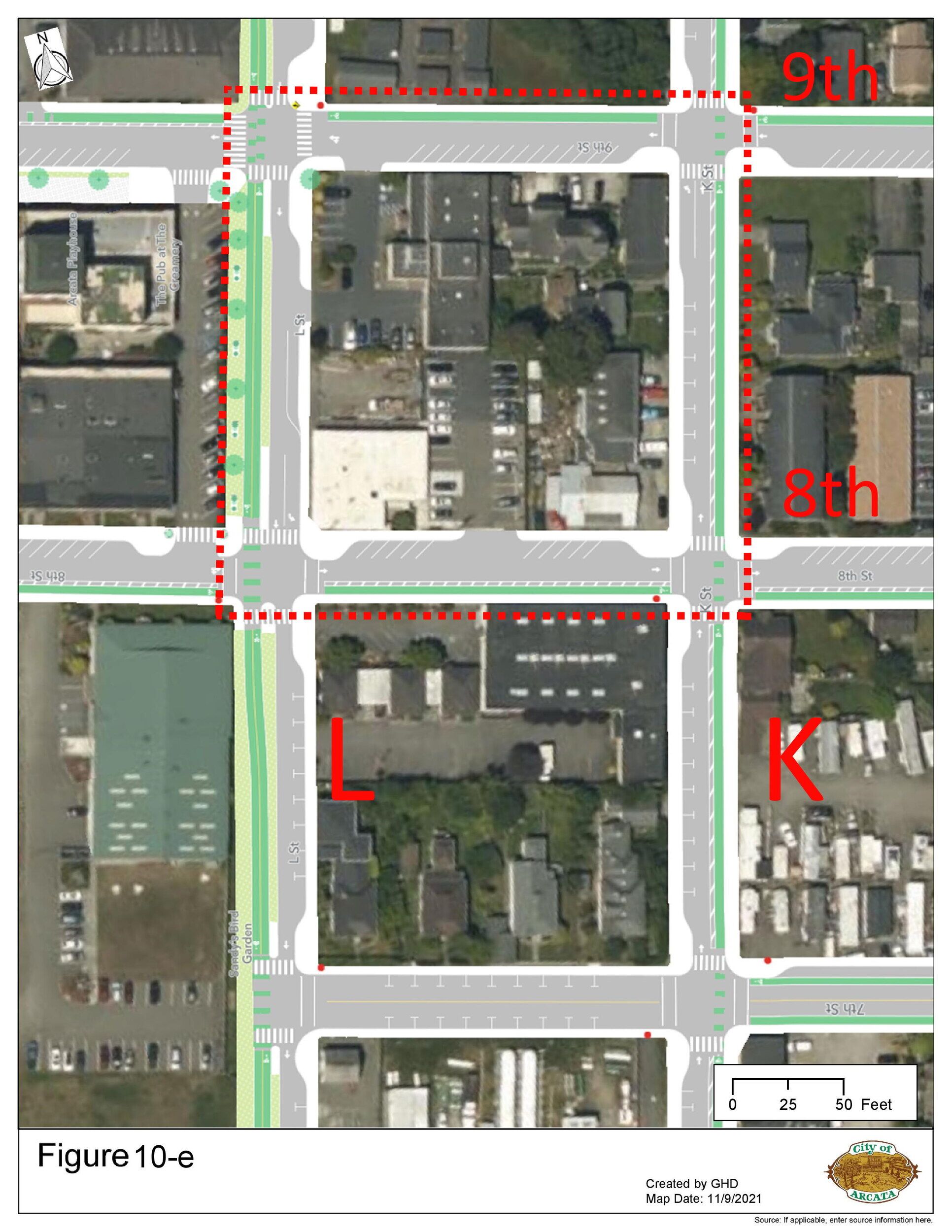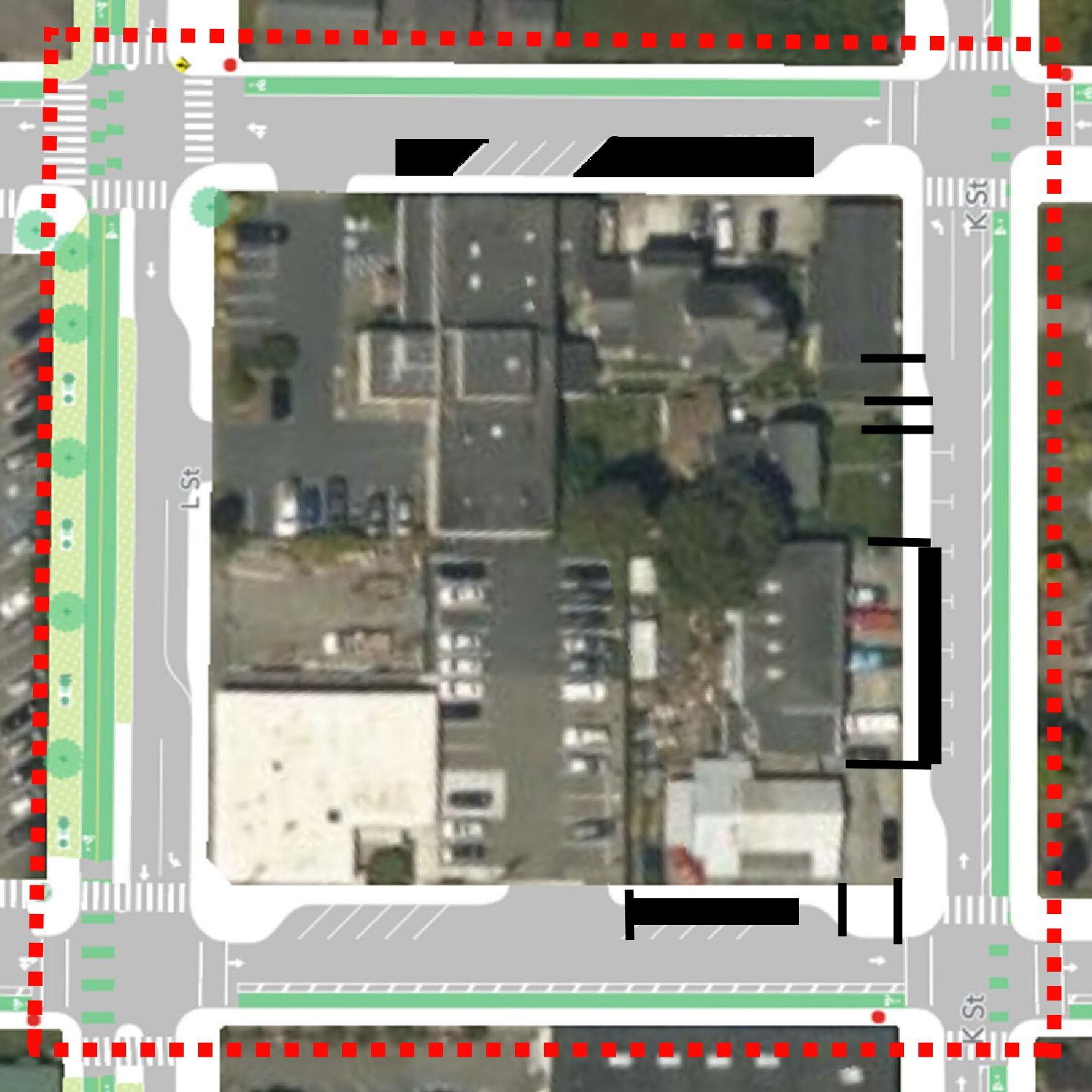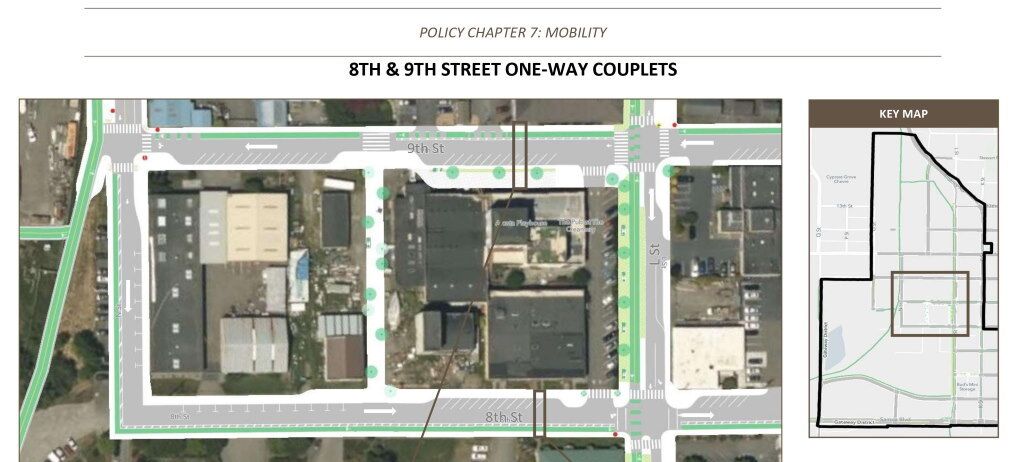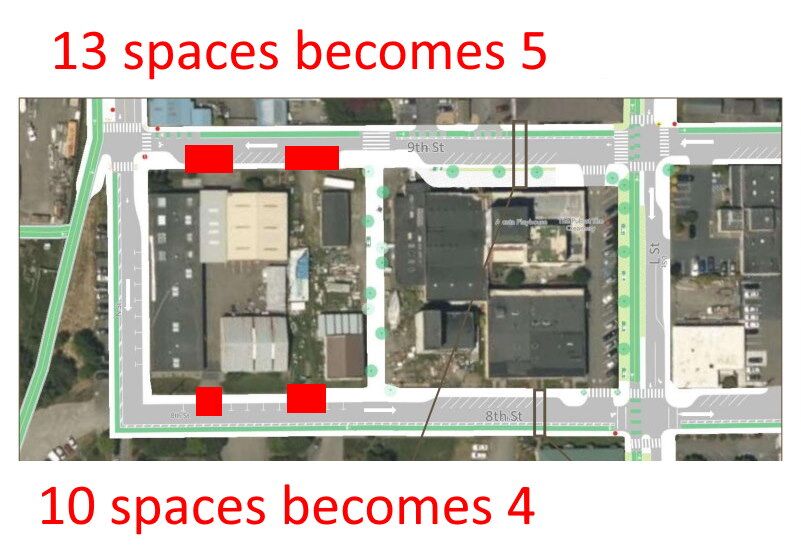For further reading, see “Getting rid of parking in Arcata: A social engineering experiment“
Let’s take a look at what the Draft Gateway proposes for on-street parking
Here’s what’s in the Draft Gateway Plan currently:
Infrastructure, Circulation, and Parking: Addressing the cost and complexity of planning, designing, and constructing new infrastructure, including a transportation system that serves everyone across all modes of transportation, while also supplying sufficient parking spaces.
Reconfiguring the street network also provides opportunities to increase the quantity and quality of on‐street parking.
What is meant by “sufficient”?
What are the opportunities to increase the quantity of the parking?
I’ve looked all the maps, and I don’t see anything close to “sufficient.” And I’ve read the entire plan, and I don’t see anything resembling an increase. All I see is a decrease.
On K Street between 8th and 9th there are about 16 parking spaces currently.
If the parking layout as proposed in the Draft Plan were put in place, there would be 2 spaces.
On K Street between 8th and 9th there are about 16 parking spaces currently. If the parking layout as proposed in the Draft Plan were put in place, there would be 2 spaces.
Oh wait — How about the industrial site “Barrel” district along Samoa. Well, I suppose there will be an increase in quantity of street parking there — because there are no streets there at all now. So, strictly speaking, any parking there will be an increase. But in the other districts it goes down. A lot.
Look at the images, and count the parking spaces
Below is Figure 10-e from the Draft Plan. (Page 100 in the October 1, 2022, draft.)
The red lines show the block between 8th & 9th Streets, between K and L Streets.
We can note that this diagram shows L Street as a southbound truck route as part of the proposed K Street – L Street Couplet. The Transportation Safety Committee is the recommending body — and they are opposed to the K Street – L Street Couplet concept in the Draft Plan. 
Here’s a close-up of that one block.
On 9th Street (at the top) there are 13 spaces shown. On K Street (on the right) there are 6 spaces shown. On 8th Street (at the bottom) there are 9 spaces shown.
The total in this fictional “high-level” diagram is 28 spaces.

Now here is that same diagram, with the actual driveway cut-outs marked in black.
The number of true parking spaces goes to 4 on 9th Street (at the top), 2 on K Street (on the right), and 5 on 8th Street.
The total in this actual street parking count is 11 spaces.

And here is a Google satellite view of this block. The vehicles in the original view were duplicated to illustrate the parking spaces.
9th Street (at the top) has 17 spaces; K Street (on the right) has 16 spaces; and 8th Street (at the bottom) has 15 spaces. The quantity of vehicles shown is tight, dense parking, but not unreasonable.
Currently there are 48 spaces on the three block-lengths of streets.

Here are the numbers of parking spaces:
| Currently | In the Draft Plan | If the plan is enacted, spaces in reality |
Parking Spaces Lost |
||
| 9th Street | 17 | 13 | 4 | 13 | |
| K Street | 16 | 6 | 2 | 14 | |
| 8th Street | 15 | 9 | 5 | 10 | |
| Totals: | 48 currently |
28 in the Draft Plan |
|
27 parking spaces lost |
Instead of the 48 current spaces, there would be 11.
Those 11 spaces amount to just 23% of what is there now.
Without accurate depictions, how can the plan be evaluated properly ?
The Fallacy of Angled Street Parking
To say that “…putting it all on one side you end up with the same amount of parking ….” is a patently false statement.
You do NOT end up with the same amount of parking. Why? Because the angled parking is just on one side of the street. Right now there is parallel parking on both sides, and the plan proposes angled parking on one side. Yes, angled parking will provide more spaces per lineal feet of roadway. If angled parking were to be on both sides of a street, then there’d be more parking. But if parking on both sides is reduced to angle parking on just one side? You lose a minimum of 27% (likely larger), even before taking into account driveway cutouts.

There are lots of advantages to angled parking, but in going from parallel parking on two sides and changing to angled parking on one side, you do NOT “end up with the same amount of parking” — it simply is not true.
With angled parking on one side only, we go from 20 to 13 spaces — a loss of 35% of our parking.
But what is said here is an exaggeration, and the image from Draft Plan shows this. In the image we can see 13 angled parking stalls on 9th Street on the M to N on-block segment (the left-side block). Looking the same M to N block on 8th Street, there are 10 parallel parking stalls. If parking were to be on both sides of the street on 8th, there’d be parking for 20 vehicles. Clearly, 13 is not the same as 20.
13 spaces amounts to 65% of what is there now.
A 9’ angled parking stall requires 12.7 feet of road length, while parallel parking requires a minimum of 18 feet. As an example, over a 200-foot uninterrupted distance, there will be with angled parking on one side of the street, there will be 16 spaces. Take away some at the ends for safety, and you have 13, as shown here. With parallel parking there would be 11 spaces in 200 feet (or, more realistically, 10) and so there’d be 20 spaces for parking on both sides of the street. With angled parking on one side only, we go from 20 to 13 spaces — a loss of 35% of our parking.
The diagrams need to show the driveway cut-outs and off-street access — where there can be no parking
Here’s a diagram of 8th and 9th Streets. We’ll look at the sections between L and N Streets.
The Draft Plan shows 23 spaces —
but when you take out for driveways,
there are only 9 spaces.


Parking on 8th & 9th Streets, between L & N, showing how driveway entrances affect the real number of spaces. Red rectangles are entrances not shown on the draft plan page.
The theoretical 23 spaces in the Draft Plan image becomes 9 spaces — a loss of 61%.
For the section on 9th street between M and N the drawing shows 13 spaces, and on 8th street between M and N the drawing shows 10 spaces. When the driveway entrances are taken into account, this becomes 5 and 4. The theoretical 23 spaces in the draft plan image becomes 9 spaces — a loss of 61%.
The draft plan pretends that there’s an emphasis of on-street parking — to compensate for a lack of the off-street parking for the to-be-built apartment buildings.
This is entirely false.
It’s not difficult to actually count the parking spaces on a few blocks of the Plan. Counting parking on all the streets wouldn’t take too many hours.
At the Open House at the Community Center on January 21 & 22, 2022 — over a year ago at this time — this was discussed briefly with Community Development Planner Joe Mateer and Director David Loya (separately).
Overall we’ll see between 50% to 80% estimated loss of street parking on certain blocks.
Overall, throughout the Gateway Area (and not including the “Barrel” district, the industrial area along Samoa Boulevard, which will be a master plan of entirely new streets), there is likely to be a 40%-50% loss of parking.
It is suggested that this be studied thoroughly.
From the Draft Gateway Plan:
Some community members have also expressed concerns about parking availability into the future.
Clearly, there are concerns.
What is the math on angled parking?
In the Gateway Plan Introductory video, here’s what’s said about parking.
This is from about 54 minutes in the video below, or see the transcript of this video here.
And so we can look at this and so, just as an example, 9th Street has a sidewalk and then a bike lane, one-lane of westbound vehicular traffic, and then angled in parking so by taking all the parking that was formally or is currently parallel parking on both sides and putting it all on one side you end up with the same amount of parking generally but all of the cars are on one side of the street making it easier for the bike lane to function.
“Putting [angled parking] all on one side you end up with the same amount of parking” — this is a false statement. With angled parking, there’s a gain of about 27% over parallel parking — for that one side of the street. By going from parallel parking on two sides to parallel parking on one side, we lose 50% of the parking.
So let’s see… first we lose 50% by having parking on just one side…. then we gain 27% by utilizing angled parking.
The theoretical maximum for an Arcata block is 20 parking spaces — 10 on each side. That’s if there are zero driveway cut-outs, which is not how things are in reality. So let’s say 8 spaces on each side. Eliminate one side — so it’s just eight. Make it be angled parking, and you gain perhaps 3 spaces — giving a total of 11. Certainly less than the original 16.
The math says that we’re left with 63.5% of the amount of parking we had in the first place. But that’s not accounting for driveway cut-outs. If it turns out that there were more driveway cut-outs on the right side of the street, then that 63.5% figure drops fast. Going from parallel on two sides to angled on one side results in 50% commonly on the blocks of Arcata.
And of course the street has to be one-way for there to angled parking at all.
The Draft Gateway Plan Community Presentation Video
from December, 2021

